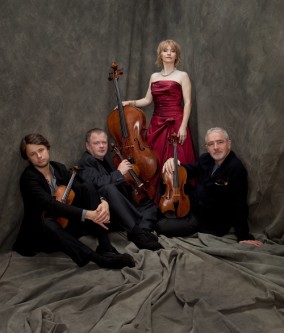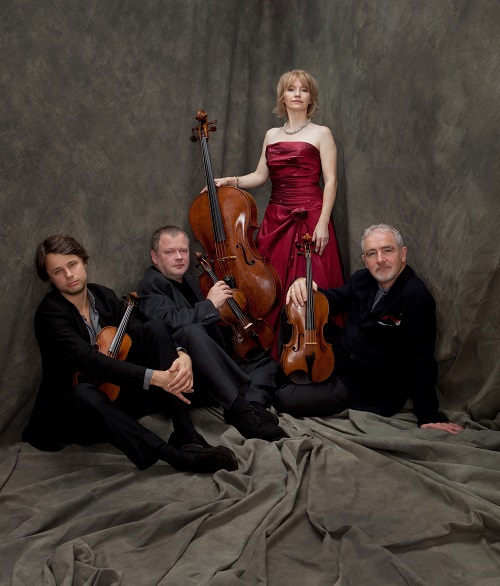
 United Kingdom Borodin, Shostakovich, J.S. Bach, Mendelssohn, Beethoven: The Brodsky Quartet (Daniel Rowland, Ian Belton, violins; Paul Cassidy, viola; Jacqueline Thomas, cello), The George Hall, The Guildhall, Swansea, 4.10.2016. (GPu)
United Kingdom Borodin, Shostakovich, J.S. Bach, Mendelssohn, Beethoven: The Brodsky Quartet (Daniel Rowland, Ian Belton, violins; Paul Cassidy, viola; Jacqueline Thomas, cello), The George Hall, The Guildhall, Swansea, 4.10.2016. (GPu)

Borodin – Scherzo in D (from Les Vendredis)
Shostakovich – String Quartet No. 8 (Op.110)
J.S. Bach – Selections from The Art of Fugue (BWV 1080)
Mendelssohn – Fugue in E flat (from Four Movements for String Quartet, Op.81)
Beethoven – Grosse Fuge (Op.133)
After grumbling, in a previous review, that the opening concert of this year’s Swansea Festival didn’t match performers to venue as aptly as it might have done, I am delighted to report that this superb concert by the Brodsky Quartet took place in a much more suitable venue. The George Hall is in the same building as the Brangwyn Hall, but is much smaller – a perfect size for chamber music, more tasteful (to my eyes and mind) in its decorative scheme, intimate yet capable of seating a very decent-sized audience. It seemed to me that this was the point at which the Festival fully got off the ground.
Though the audience were, indeed, comfortably seated, the musicians of the Brodsky Quartet (save, of course, the cellist) chose to stand up throughout. This made possible a kind of physical embodiment of the music, with each of the violinists and the violist at one moment standing on tiptoe, at another bending over, at a third shifting weight from one foot to the other, and so on (individually, I mean, not in some sort of group choreography!). None of this was remotely gimmicky, but all of it was expressive of specific passages and moments in the music and how it was being played. I think that being on their feet, with the additional freedom of physical movement that gave them perhaps contributed to the remarkable sense of energy with which they played throughout.
While I wouldn’t claim to know Borodin’s Scherzo in D particularly well, I have listened to a number of recorded performances of it. None of them had prepared me for the fiercely-driven music this Quartet found in the score. Post-announcing the work, Daniel Rowland, leader of the Brodsky Quartet expressed his amazement that it had originally been written for performance by amateur musicians, members of a group of music lovers who met regularly (on Friday evenings) at the St. Petersburg house of M.P. Belyaev – a successful merchant and a generous patron of the arts (especially music). But I dare say that the original quartet didn’t play this music with anything approaching the intensity of the Brodsky Quartet. Serge Dainin, in his important and well-informed book on the composer (translated by Robert Lord, Borodin, 1963) describes this piece (later incorporated in Borodin’s unfinished Third Symphony) as a “light, fantastic scherzo” and observes (partly it seems on the basis of comments by Glazunov, another regular at those Friday evenings) that the quartet who first played the Scherzo “were not at their strongest in the question of purity of intonation and technique”. No such comments could be made about the Brodsky Quartet and their performance of the Scherzo. Their interpretation was not only ferocious in attack; on the slower section, there was real poignancy, not least in the work of cellist Jacqueline Thomas. The closing ‘dance’ – with debts to the gopak – made the recorded performances I have heard seem unduly polite and tame (another adjective not applicable to the performance by the Brodskys!)
The printed programme of the Festival told us that the second piece would be the seventh of Shostakovich’s String Quartets, but Daniel Rowland announced and introduced (eloquently) the Eighth Quartet, speaking of one of its most significant contexts, the composer’s visit to the bomb-shattered city of Dresden. In July 1960, Shostakovich spent some days in a GDR guesthouse at Gohrisch, some 40 kilometres south-west of Dresden. He seems to have composed, or at any rate substantially drafted, the Eighth Quartet in just three days (12th-14th July) there, after visiting Dresden. He was shocked and pained, unsurprisingly, by his experience of the city, still largely unrestored after the destructive bombing of the winter of 1944-5. His response to that horror, and to the destructive futility of war, permeates the quartet, mixed with Shostakovich’s own wartime experiences in Russia and of his own persecution by Stalin (articulated, in part, by a good deal of self-quotation). The composer dedicated the Quartet to the “victims of Nazism”. Had it not been so dangerous to do so, one wonders whether he might not have dedicated it to the “victims of tyranny” – so as to make clear its relevance to the Russian experience too. Incorporating quotations from his Cello Concerto and from Lady Macbeth of Mtsensk, the quartet, in addition to its ‘subject’ of Dresden has a clear autobiographical dimension too.
The opening Largo, though insistent in its thoughtfulness, was not lingered over, and certainly wasn’t allowed the kind of near-lushness it gets in some performances. Even in the Largo here, a head of steam was building and the barely contained energy burst forth in the ensuing Allegro molto, which seemed to speak both of the explosive destruction of Dresden and the many concomitant deaths, and also of Shostakovich’s anger at it and the mass sufferings also ‘created’ by Hitler and Stalin, Nazism and communism. Throughout the Brodsky’s intense playing of this Quartet, anger and grief were inextricably bound up one with the other, or succeeded one another in so rapid and organic a fashion as to seem inseparable. Accents here were hammered out with real, but controlled, fury and there was no fear of harsh textures or tones. The sardonic quasi-waltz which forms the third movement at times sounded almost like a monstrous and demented hurdy-gurdy, while the fourth movement, another Largo (with its introductory quotation from the Dies Irae) offered, if not resolution or forgiveness, a certain momentary relaxation of tension, before in the closing Largo, in which the autobiographical motto (DSCH, D – E flat – C – B in German notation) is especially prominent, a kind of painful yearning asserted itself and the music finally faded away into a pained silence. This was a searing and extraordinarily powerful performance of one of the greatest of modern string quartets, memorable in its intensity and communicative power.
I dare say the musicians needed an interval at this point, and that many in the audience were (like me) also grateful for a few minutes in which to digest, as far as they could, what they had just heard. Proceedings after the interval were, initially at least, rather less intense. Viola player Paul Cassidy apologized very gracefully on behalf of the quartet for their having played the eighth rather than the seventh quartet, and told us that we were a very polite audience, having made no fuss about the matter!
Everything in the second half of the concert was fugal. The concert recommenced with two pieces from The Art of Fugue, the first slow and ravishingly beautiful, making it clear this was a Quartet which could produce gorgeous textures as well as the ferocity that had characterized much of their playing in the first half of the concert. The second piece from Bach left one marvelling (not for the first or last time) at Bach’s inventiveness, at his ability to sound so seemingly spontaneous within such a strict form. The theme (no pun intended!) of the fugue continued with the Fugue in E flat from Mendelssohn’s Four Pieces for String Quartet. As the title suggests these four movements (Andante in E / Scherzo in A minor / Capriccio in E minor / Fugue in E flat) were not intended as a four-movement quartet, though they have sometimes been played as such. Each is a discrete work, a free-standing movement; all were written between 1827 and 1847, the Fugue being the earliest of the four. It is, emotionally speaking, a relatively ‘empty’ piece, though technically very accomplished. The fugal writing owes something (inevitably) to the example of Bach, as well as to that of the late Beethoven. The result is a serious, but not solemn, piece and it was played with considerable grace by the Brodsky Quartet.
Something on an altogether different scale, altogether more powerful, followed in the form of Beethoven’s astonishing (one might say awesome) Grosse Fuge in B flat for String Quartet, published on its own as Opus 133, though Beethoven had originally intended it to be the last movement of his String Quartet Op.130. Robert Simpson once shrewdly observed (I can’t now remember where, but the quotation is in one of my old notebooks) that “For some reason the key of B flat became for [Beethoven] the vehicle of immense power struggles – witness the ‘Hammerklavier’ sonata, the ‘Credo’ from the Missa solemnis, the Grosse Fuge” and no one who heard this performance of the Grosse Fuge by the Brodsky Quartet could, surely, have been left in any doubt that it belongs in such elevated company. As their performance of Shostakovich 8 earlier in the evening had already done, this reading of the Grosse Fuge demonstrated the Quartet’s strong architectural sense. Certainly I, at least, have rarely, if ever, heard a performance more beautifully shaped and clearly delineated. On occasion I have heard performances of this remarkable work which make it sound like an academic exercise (albeit an unusually ‘sublime’ one). I don’t think that the Brodsky Quartet, as presently incarnated, could sound merely academic if it tried. Vincent d’Indy, quoted in my 1929 edition of Cobbett’s Cyclopedic Survey of Chamber Music describes the Grosse Fuge as a “somewhat strange work” full of “mysterious beauties … revealed only to those who can rise to the heights of the Beethoven spirit”. The Brodsky Quartet did so, very compellingly, on this occasion. They communicated, to something like perfection, what d’Indy went on to describe as a kind of “open war between careless merriment and serious thought, the latter gradually winning over its thoughtless and frivolous opponent”. From the fortissimo dotted half notes in the ‘Overtura’ to the triumphant thematic expansion in the Coda, the Brodsky Quartet fused, as they had throughout the evening, passion and precision. At the close of the Grosse Fuge the sense of things resolved had an emotional, even an ethical meaning, not just a formal one.
In short, since this review has grown rather long, this was one of the very finest concerts given by a String Quartet that I have been fortunate enough to attend, and is one that I shall long remember.
Glyn Pursglove
